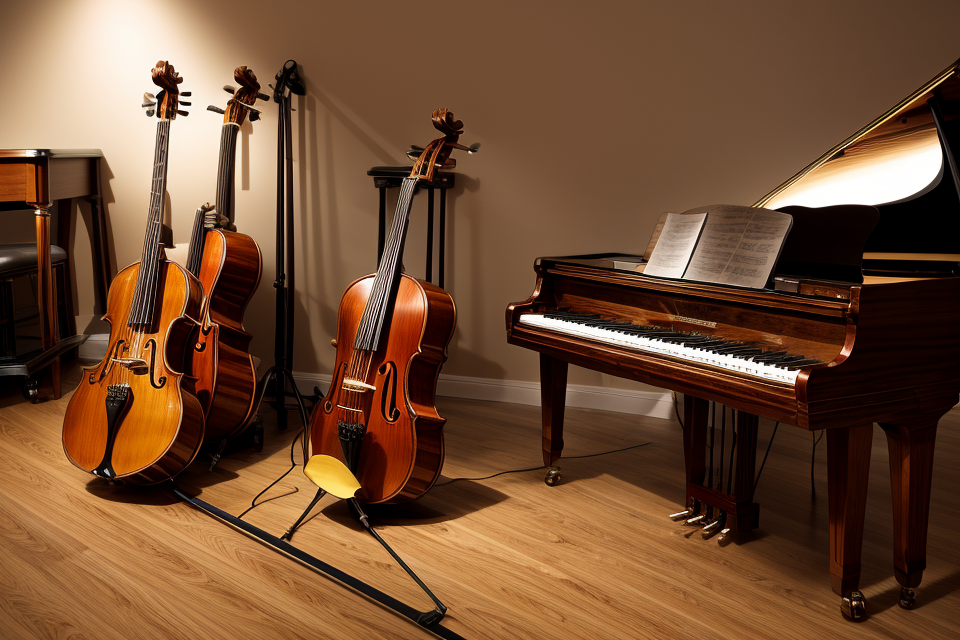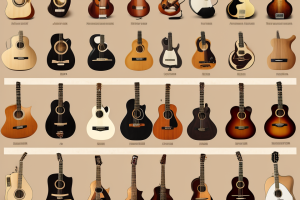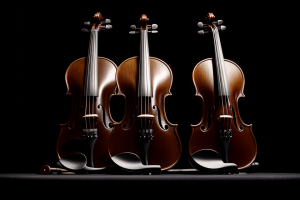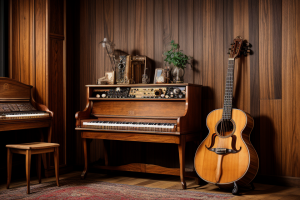
As musicians, we all want our instruments to last as long as possible. After all, they are a significant investment and an essential part of our craft. But how long can an instrument truly last? In this article, we will explore the factors that contribute to an instrument’s longevity and provide tips on how to prolong the life of your musical equipment. From proper maintenance to recognizing the signs of wear and tear, we’ll cover everything you need to know to keep your instruments in top condition for years to come. So, whether you’re a beginner or a seasoned pro, read on to discover the secrets to extending the life of your musical instruments.
Factors Affecting Instrument Longevity
Material Quality
High-quality materials vs. low-quality materials
In the world of musical instruments, the quality of materials used can significantly impact the longevity of the equipment. Instruments constructed with high-quality materials tend to be more durable and withstand the test of time, while those made with low-quality materials may deteriorate more quickly. High-quality materials are often more resistant to wear and tear, allowing the instrument to maintain its structural integrity over time.
Durability of specific materials
When it comes to specific materials, some are known for their exceptional durability in instrument construction. For example, wood is a common material used in the construction of stringed instruments like violins and cellos. The density and grain pattern of the wood can affect its overall durability. High-density woods, such as maple or spruce, are often used in the construction of instrument bodies because they can withstand the tension of strings and resist cracking or warping over time.
Metal, another popular material used in instrument construction, also varies in its durability. Brass and bronze are commonly used for brass instruments like trumpets and trombones, while aluminum and steel are used for guitar and bass strings. The specific composition of these metals can impact their resistance to corrosion and their overall durability.
Plastic, while not as commonly used in instrument construction, is also a material to consider when examining material quality. Some types of plastic, such as polycarbonate, are known for their strength and durability, making them suitable for use in instruments like clarinets and flutes.
Overall, the material quality of an instrument plays a crucial role in determining its longevity. Instruments constructed with high-quality materials are more likely to withstand the test of time and maintain their performance capabilities, while those made with low-quality materials may degrade more quickly and require more frequent maintenance or replacement.
Construction and Design
When it comes to the longevity of musical instruments, the construction and design play a crucial role. Here are some key factors that determine how long your instrument will last:
Craftsmanship and attention to detail
The level of craftsmanship and attention to detail in the instrument’s construction can significantly impact its lifespan. Instruments that are made with precision and care are more likely to withstand the wear and tear of regular use. Look for signs of high-quality craftsmanship, such as tight-fitting joints, smooth action, and consistent finishes. These details may seem minor, but they can make a big difference in the long run.
Reinforcement and support mechanisms
Reinforcement and support mechanisms are essential in ensuring the durability of an instrument. For example, the neck of a guitar or the body of a bass should be reinforced to prevent it from warping or breaking over time. Look for instruments that have additional layers of wood or other reinforcement techniques built into their design. These features can help to prolong the life of your instrument and keep it in good condition for years to come.
Durability of specific features
The durability of specific features, such as tuning machines and hardware, can also impact the overall longevity of an instrument. Look for instruments that have high-quality tuning machines that are easy to use and durable enough to withstand frequent tuning changes. Similarly, hardware such as pickups, knobs, and controls should be made from high-quality materials that can withstand regular use without breaking or wearing out.
In summary, the construction and design of an instrument play a crucial role in determining its longevity. Look for instruments that have been crafted with precision, reinforced with support mechanisms, and built with durable materials in key features such as tuning machines and hardware. By choosing an instrument that has been designed with these factors in mind, you can help to ensure that it will provide you with many years of reliable performance.
Maintenance and Care
Proper cleaning and lubrication
Regular cleaning and lubrication are essential for the longevity of your musical equipment. Dust, dirt, and grime can accumulate on instruments and cause damage over time. It is important to clean your instrument regularly to prevent the buildup of dirt and debris. This can be done using a soft, dry cloth to wipe down the instrument after each use. Additionally, it is important to lubricate moving parts, such as tuning pegs and keys, to ensure smooth operation.
Regular tuning and adjustments
Regular tuning and adjustments are also crucial for the longevity of your musical equipment. Instruments will naturally lose their tuning over time, especially if they are used frequently. It is important to tune your instrument regularly to maintain its optimal performance. Additionally, regular adjustments may be necessary to ensure that the instrument stays in good condition. For example, if you play a stringed instrument, you may need to adjust the truss rod or bridge to maintain proper intonation.
Protection from extreme temperatures and humidity
Extreme temperatures and humidity can have a significant impact on the longevity of your musical equipment. Instruments should be stored in a cool, dry place to prevent damage from extreme temperatures. Excessive humidity can cause wood to swell, which can affect the instrument’s playability and overall condition. It is important to protect your instrument from extreme temperatures and humidity to ensure that it stays in good condition for as long as possible.
Use and Storage
When it comes to maintaining the longevity of your musical instruments, the way you use and store them plays a significant role. Here are some key points to keep in mind:
- Avoiding excessive force or impact: It’s important to handle your instruments with care to prevent damage. This means avoiding excessive force or impact that could cause scratches, dents, or other types of damage to the instrument. Be gentle when holding or moving your instrument, and avoid dropping it or subjecting it to rough handling.
- Proper storage to prevent damage: How you store your instrument can also have a big impact on its longevity. For example, hanging your instrument by its neck using a hook or a strap can put unnecessary stress on the neck and body of the instrument, which can lead to cracks or other types of damage over time. Instead, consider storing your instrument in its case or on a soft, cushioned surface.
- Limiting exposure to dust, dirt, and liquids: Dust, dirt, and liquids can all be harmful to your instrument, so it’s important to limit its exposure to these elements. Dust and dirt can accumulate on the instrument and cause scratches or other types of damage, while liquids can damage the wood, electronics, or other components of the instrument. When cleaning your instrument, use a soft, dry cloth to wipe away any dust or dirt, and avoid using any liquids or chemicals that could damage the instrument.
Prolonging Your Instrument’s Lifespan
Choosing the Right Instrument
When it comes to prolonging the life of your musical equipment, choosing the right instrument is crucial. Here are some factors to consider when selecting an instrument:
- Selecting high-quality materials and craftsmanship: An instrument made from high-quality materials and crafted with precision will not only sound better but also last longer. Look for instruments that are made from solid wood instead of plywood or particleboard, and those with solid brass or silver keys instead of plastic. These materials may be more expensive upfront, but they will provide better value in the long run.
- Choosing an instrument suited for your skill level and playing style: It’s important to choose an instrument that’s suitable for your skill level and playing style. A beginner violin, for example, won’t produce the same sound quality as a professional-grade instrument, but it will be more affordable and durable for a beginner player. Similarly, a professional pianist will require a different type of piano than a beginner or hobbyist.
- Considering the cost of future upgrades or repairs: Even the best-made instruments will require maintenance and repairs over time. Consider the cost of future upgrades or repairs when choosing an instrument. For example, a woodwind instrument with a higher-end mechanism may require more frequent maintenance, but it will provide better tone and response. Additionally, consider the availability of replacement parts and the cost of labor in your area when making your decision.
Regular Maintenance and Upkeep
Scheduling Regular Tune-Ups and Adjustments
One of the most important aspects of prolonging the life of your musical equipment is scheduling regular tune-ups and adjustments. This means taking your instrument to a professional repair person or technician on a regular basis to have it checked and adjusted as needed. This can help to ensure that your instrument stays in good working order and can help to prevent small problems from becoming bigger ones.
Cleaning and Lubricating Your Instrument Regularly
Another important aspect of regular maintenance is cleaning and lubricating your instrument regularly. This can help to keep it looking and functioning its best. For example, if you play a guitar, you should wipe down the strings and fretboard with a soft cloth after each use to remove any dirt or debris. You should also oil the fretboard and any moving parts on a regular basis to keep them lubricated.
Addressing Any Issues Promptly
It’s also important to address any issues with your instrument promptly. If you notice that something doesn’t feel or sound right, don’t ignore it. Bring your instrument in for a check-up as soon as possible to avoid any potential damage. Ignoring small problems can often lead to bigger and more expensive problems down the road.
Overall, regular maintenance and upkeep is crucial for prolonging the life of your musical equipment. By scheduling regular tune-ups, cleaning and lubricating your instrument regularly, and addressing any issues promptly, you can help to ensure that your instrument stays in good working order for years to come.
Proper Storage and Transportation
Storing your instrument in a safe, dry place
When not in use, it is crucial to store your instrument in a safe and dry place. This means avoiding exposure to extreme temperatures, humidity, and direct sunlight, which can cause damage to the instrument over time. Ideally, the storage space should be clean, well-ventilated, and free from dust and dirt.
Using protective cases or covers when transporting your instrument
Transporting your instrument from one location to another can be risky, as it can be easily damaged during transit. To protect your instrument, it is important to use a protective case or cover when transporting it. This will help to cushion the instrument and prevent it from being scratched or dented.
Checking for damage during transportation
Before storing or transporting your instrument, it is essential to check it for any existing damage. This includes checking for cracks or breaks in the body or neck, loose tuning pegs, or any other issues that may affect the instrument’s performance. If you notice any damage, it is important to address it immediately to prevent further damage or deterioration.
Proper storage and transportation are essential for prolonging the life of your musical equipment. By following these guidelines, you can ensure that your instrument remains in good condition and continues to perform at its best for years to come.
Adapting Your Playing Style
One of the most effective ways to prolong the life of your musical equipment is by adapting your playing style. Here are some tips to help you do just that:
- Avoiding excessive force or impact: One of the most common reasons why instruments break or become damaged is due to excessive force or impact. To avoid this, it’s important to be mindful of the amount of pressure you’re applying to your instrument while playing. For example, if you’re playing the guitar, be careful not to apply too much pressure when strumming or plucking the strings. If you’re playing the piano, be mindful of the amount of force you’re using when pressing down on the keys.
- Learning proper technique to reduce wear and tear: Proper technique can help reduce wear and tear on your instrument. For example, if you’re playing the violin, make sure you’re holding the bow correctly and using the right amount of bow pressure. If you’re playing the trumpet, make sure you’re using the correct embouchure and breathing technique. By learning proper technique, you can help prevent unnecessary wear and tear on your instrument.
- Adjusting your playing style as needed to preserve your instrument: As your instrument ages, it may require some adjustments to your playing style to help preserve it. For example, if you’re playing an older guitar, you may need to be more mindful of the types of strings you use, as certain strings can put more pressure on the instrument. If you’re playing a vintage horn, you may need to be more careful when cleaning and maintaining it to avoid damaging it. By adjusting your playing style as needed, you can help ensure that your instrument remains in good condition for years to come.
Extending the Life of Your Instrument with Repairs and Restoration
Recognizing the Need for Repairs
Identifying Common Issues
- Loose tuning machines: Over time, tuning machines can become loose, causing the strings to slip out of tune. To address this issue, check the tuning machines regularly and tighten them as needed. If the problem persists, consider replacing the tuning machines.
- Worn-out strings: Worn-out strings can affect the sound quality and playability of your instrument. Inspect the strings for signs of wear, such as discoloration or fraying. If the strings appear worn, replace them with new ones.
Knowing When to Seek Professional Help
- Complex repairs: Some repairs require specialized knowledge and tools that may not be readily available to the average user. For instance, repairing a cracked wooden instrument or restoring a vintage electronic device may require the expertise of a professional repair technician. In such cases, it is advisable to seek professional help to ensure the job is done correctly.
- Unusual or unfamiliar issues: If you encounter an issue with your instrument that you have never encountered before or are unsure how to address, it is best to consult with a professional. A repair technician can provide guidance on the best course of action and perform the necessary repairs to restore your instrument to its optimal condition.
Types of Repairs
Basic repairs
Basic repairs are essential to maintaining the functionality of your instrument. These repairs can be performed by a skilled technician or by the musician themselves, depending on the level of expertise and the tools available. Basic repairs include:
- String replacement: Over time, strings can wear out, break, or become corroded. Regular string replacement is crucial to maintaining the proper tension and pitch of the instrument. This is a relatively simple process that can be done at home by replacing the old strings with new ones of the same gauge.
- Tuning machine adjustments: The tuning machines are responsible for adjusting the tension of the strings, which affects the pitch of the instrument. If the tuning machines become loose or worn, the instrument may need to be re-tuned frequently or may not hold its tuning at all. A skilled technician can adjust or replace the tuning machines as needed.
More extensive repairs
More extensive repairs are typically required when the instrument has suffered damage due to wear and tear, neglect, or accidents. These repairs may involve the use of specialized tools and techniques and may require the expertise of a professional technician. Some examples of more extensive repairs include:
- Crack repair: Cracks can develop in the body or neck of the instrument due to changes in temperature and humidity, or as a result of rough handling. A skilled technician can repair cracks using various techniques, such as gluing, clamping, or brazing. The type of repair will depend on the location and severity of the crack.
- Refinishing: Over time, the finish on an instrument can become dull, scratched, or damaged. Refinishing the instrument can restore its appearance and protect it from further damage. This is a complex process that involves sanding, filling, priming, and painting or varnishing the instrument. It should only be done by a professional technician with experience in refinishing instruments.
Customizations and upgrades
Customizations and upgrades are optional repairs that can enhance the performance or aesthetics of the instrument. These repairs can range from simple changes, such as switching out the pickups or adding a pickup, to more complex modifications, such as changing the neck or adding a new fretboard. Some examples of customizations and upgrades include:
- Changing the pickups: Pickups are responsible for converting the vibrations of the strings into electrical signals that can be amplified. Different pickups can produce different tones, so changing the pickups can significantly affect the sound of the instrument. A skilled technician can install new pickups, or the musician can do this themselves with the right tools and knowledge.
- Adding a pickup: Some instruments may not have a pickup installed, but the musician may want to amplify their instrument. Adding a pickup can enable the instrument to be amplified, which can be useful for performances or recordings. A skilled technician can install a new pickup, or the musician can do this themselves with the right tools and knowledge.
Restoration and Revitalization
- Restoring vintage or antique instruments
- Revitalizing older instruments with new parts or upgrades
- Preserving the historical value of your instrument
Restoring Vintage or Antique Instruments
When it comes to restoring vintage or antique instruments, the key is to preserve their original character while addressing any necessary repairs. This often involves a meticulous process of cleaning, repairing, and refinishing the instrument to its original condition. For example, a skilled luthier may use traditional techniques to replace a cracked or damaged piece of wood, while ensuring that the grain pattern and color match the original material.
In some cases, a vintage instrument may have parts that are no longer available or are difficult to source. In these situations, craftsmen may use their expertise to create replica parts that are as close to the original as possible. These replica parts are often made from the same types of wood or other materials used in the original instrument, and are designed to blend seamlessly with the existing components.
Revitalizing Older Instruments with New Parts or Upgrades
Revitalizing older instruments with new parts or upgrades can not only improve their performance, but also extend their lifespan. For example, a guitar that has developed cracks or other damage over time may benefit from a neck reset, which involves adjusting the angle of the neck to improve its stability and playability. Similarly, a violin that has lost its original tone may be restored to its former glory through the installation of a new soundpost or bass bar.
In some cases, upgrading the electronics of an older instrument can also enhance its performance. For instance, a vintage amplifier may be retrofitted with modern components, such as more efficient power supplies or improved circuitry, to improve its reliability and output.
Preserving the Historical Value of Your Instrument
Preserving the historical value of your instrument is an important consideration when undertaking any restoration or revitalization work. This means taking care to retain as much of the original material and components as possible, while still addressing any necessary repairs or upgrades. In some cases, this may involve documenting the history and provenance of the instrument, or conducting research to determine the most appropriate restoration techniques based on the instrument’s age and condition.
Ultimately, the goal of restoration and revitalization is to extend the life of your instrument while preserving its unique character and historical significance. By working with skilled craftsmen and technicians, you can ensure that your instrument remains in excellent condition for years to come, allowing you to continue making beautiful music.
FAQs
1. How long can an instrument last?
The lifespan of an instrument can vary greatly depending on the type of instrument, how often it is used, and how well it is maintained. Some instruments, such as violins and cellos, can last for hundreds of years if they are well cared for. Other instruments, such as electric guitars and keyboards, may need to be replaced more frequently due to the wear and tear of their electronic components.
2. How can I prolong the life of my instrument?
One of the most important things you can do to prolong the life of your instrument is to maintain it regularly. This includes things like cleaning and tuning your instrument, as well as having it inspected by a professional on a regular basis. It is also important to store your instrument properly when it is not in use, as extreme temperatures and humidity can cause damage.
3. What are some common issues that can shorten an instrument’s lifespan?
There are several factors that can shorten the lifespan of an instrument. These include exposure to extreme temperatures and humidity, as well as physical damage from things like drops and bumps. Using the wrong type of strings or accessories can also cause damage to your instrument over time. Additionally, not maintaining your instrument regularly can lead to wear and tear that can shorten its lifespan.
4. When is it time to replace my instrument?
There are several signs that may indicate that it is time to replace your instrument. These include things like difficulty keeping it in tune, noticeable changes in sound quality, or physical damage that cannot be repaired. If you are unsure whether it is time to replace your instrument, it is a good idea to have it inspected by a professional.
5. How can I extend the lifespan of my instrument’s accessories?
Just like your instrument, the accessories you use with it can also benefit from regular maintenance. This includes things like cleaning and replacing strings, as well as making sure that any electronics are well-maintained. Storing your accessories properly when they are not in use can also help to prolong their lifespan.







